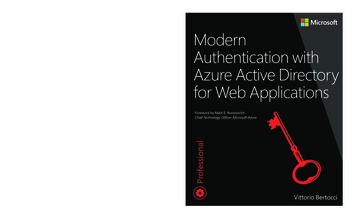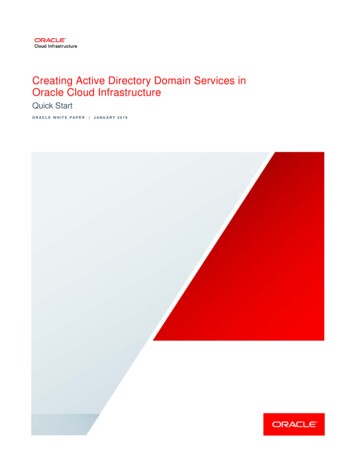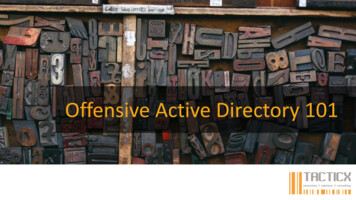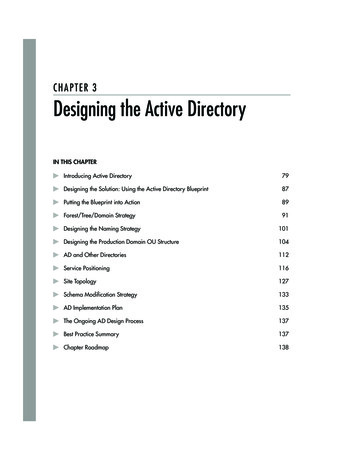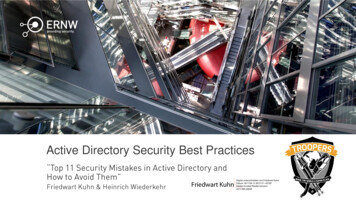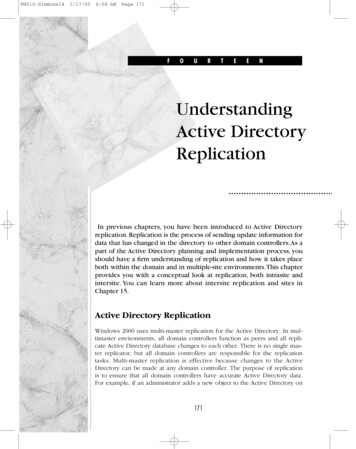
Transcription
PH010-Simmons142/17/006:56 AMPage 171FOURTEENUnderstandingActive DirectoryReplicationIn previous chapters, you have been introduced to Active Directoryreplication. Replication is the process of sending update information fordata that has changed in the directory to other domain controllers.As apart of the Active Directory planning and implementation process, youshould have a firm understanding of replication and how it takes placeboth within the domain and in multiple-site environments.This chapterprovides you with a conceptual look at replication, both intrasite andintersite. You can learn more about intersite replication and sites inChapter 15.Active Directory ReplicationWindows 2000 uses multi-master replication for the Active Directory. In multimaster environments, all domain controllers function as peers and all replicate Active Directory database changes to each other. There is no single master replicator, but all domain controllers are responsible for the replicationtasks. Multi-master replication is effective because changes to the ActiveDirectory can be made at any domain controller. The purpose of replicationis to ensure that all domain controllers have accurate Active Directory data.For example, if an administrator adds a new object to the Active Directory on171
PH010-Simmons141722/17/006:56 AMPage 172Chapter fourteen Understanding Active Directory Replicationa particular domain controller, that domain controller is responsible forsending that change to all other domain controllers. Without effective replication, an Active Directory environment would quickly fall apart since eachdomain controller would be unaware of changes made by other domaincontrollers.It is important to note the difference between directory replication anddirectory synchronization. Replication occurs between domain controllers ina Windows 2000 network. Directory synchronization occurs between different directories, such as Active Directory and Novell Directory Service (NDS).Since each directory uses a different schema, an agent is established that isconsidered a security principal for both directories. The agent replicatesdata between the two directory services by mapping between the twoschemas. This process is known as synchronization.The Replication ProcessActive Directory replication is performed through multi-master replicationand only changes are replicated. In other words, changes to the ActiveDirectory can be made at any domain controller and only the change that ismade will be replicated to all other domain controllers. The replicationprocess is invisible to administrators and users.Once a change has been made, the process ensures the data is replicated to domain controllers and that errors do not occur. The following sections outline the replication process.Change NotificationThe process begins with a “change notification.” This change notification issent to all domain controllers so they know there has been a change in theActive Directory database and that change is about to be replicated. Oncethe change notification has been sent, the process continues with an“update request.”Update RequestWhen a domain controller needs to replicate update data, an “originatingupdate” is established. An originating update determines the kind of changethat needs to be made to the Active Directory database. There are four different kinds of originating updates—add, modify, modifyDN, and delete.The add update adds an object to the Active Directory. For example, if youadd a new shared folder, the add update replicates the information to alldomain controllers. The modify update changes an attribute of an existingobject. For example, if you change a user account’s group membership, themodify update replicates this change. Next, the modifyDN update changes
PH010-Simmons142/17/006:56 AMPage 173two Implementing the Active Directory173the name of an object or an object’s parent. Finally, the delete updatedeletes an object from the Active Directory.By using originating updates, changes to the Active Directory can bereplicated (Figure 14.1). The task of creating an originating update is performed at the domain controller where the change was made. When thechange is replicated to the other domain controllers, the update is known asa “replicated update” on those domain controllers. The replicated updateoccurs because of an originating update from another domain controller.When an originating update occurs, a stamp is attached to the updatedattribute so it can be updated on all domain controllers.A major feature of the replication process is Update SequenceNumbers (USNs). USNs are assigned numbers that are stored in a USN tableon each domain controller. The USN table is used to determine the updatesthat need to occur between domain controllers. In other words, when achange occurs in the Active Directory, the domain controller where thechange was made updates the USN so that all other domain controllershave an outdated USN for that attribute. When replication occurs, the USNis updated on all domain controllers. The USN allows other domain controllers to know they have an outdated USN and that the replication updateOriginating UpdateReplicated UpdateReplicated UpdateReplicated UpdateFIGURE 14.1Originating and replicated updates
PH010-Simmons141742/17/006:56 AMPage 174Chapter fourteen Understanding Active Directory Replicationneeds to be processed. Due to the use of USNs, timestamps on replicationdata are not necessary, although they are still maintained by the ActiveDirectory and used in certain circumstances. For example, if an administrator at one domain controller makes a change to a user account phone number and an administrator at another domain controller makes the samechange, the timestamp is used to “break the tie” between the two updates.Another potential problem with Active Directory replication is unnecessary replication traffic. The Active Directory maintains a replication “loop”so that domain controllers have more than one path for sending and receiving replication traffic. However, the loop could allow updates to be sent tothe same domain controller more than once. The Active Directory preventsthis through a process called “propagation dampening.” Propagation dampening allows domain controllers to detect when replication of data hasalready occurred on other domain controllers. When the domain controllersdetect this, they do not send the same replication data where it has alreadybeen replicated. Figure 14.2 gives you a basic representation of propagationServer5Server4Server3 has alreadyreceived the replicateddata. Server4 detects thisand performs propagationdampening so the replicationis not repeated on Server3Server1Server3Server2FIGURE 14.2Propagation dampening
PH010-Simmons142/17/006:56 AMPage 175two Implementing the Active Directory175dampening. Because replication has already occurred at Server3, Server4halts the replication to Server3 through propagation dampening. This prevents Server3 from receiving the same replication data twice.Propagation dampening occurs through the use of two vectors.Vectors are made up of pairs of data that combine a GUID (globally uniqueidentifier) and a USN. The two vectors are called the up-to-date vector andthe high watermark vector. The up-to-date vector contains server USN pairsand represents the highest originating update. The high watermark vectorholds the USN numbers for attributes that have been added or modified inthe directory and are stored in the replication metadata (which is simply“data about data”) for that attribute. Through both vectors, propagationdampening can occur and unnecessary Active Directory updates can beavoided. Propagation dampening is an internal process and one that isinvisible to administrators.Along with propagation dampening, the Active Directory replicationalso has the task of solving replication conflicts. Since the Active Directoryuses multi-master replication, there can be conflicts in changes. For example,if two administrators working on two different domain controllers makechanges to the same attribute on the same object, a “collision” will occurwhen the data is replicated. The Active Directory attempts to minimize collisions by replicating data changes at the attribute level instead of the objectlevel. This way, two different administrators on two domain controllers canmake changes to the same object. As long as they are not making changes tothe same attribute of that object, a collision will not occur. However, even thestrategy of attribute level replication does not stop all collisions. In this case,the Active Directory must resolve collisions that occur. Resolution is accomplished through the use of timestamps and version numbers that are recordedin the metadata for that attribute. In the case of a collision, the domain controller(s) where the collision occurs will examine the timestamp and versionnumber of the attribute and use the one that has the highest value. In theextreme case where the version numbers and timestamps match, then thehighest Active Directory GUID would be used to break the tie. In any case,this collision resolution process ensures that the latest change to the objectattribute always wins the resolution and is updated in the database.Understanding Replication PartitionsReplication in an Active Directory environment functions at three major levels, and you should have a firm understanding of how partition replicationoccurs as this may impact some decisions you make as you design yourActive Directory infrastructure. The three partitions are schema, configuration, and domain.
PH010-Simmons141762/17/006:56 AMPage 176Chapter fourteen Understanding Active Directory ReplicationThe schema partition contains object and attribute definitions. In otherwords, the schema partition contains a list of definitions that define whatobjects and attributes for those objects can exist in the Active Directory.Schema information is enterprise in nature—all domain controllers in a treeor forest share a common schema and any schema modifications are replicated across the forest. Because the schema defines objects and attributes,an object that is created, along with it’s attributes, must conform to the definitions of the schema.The configuration partition contains information about the physicalstructure of the Active Directory, such as the sites and domains and wheredomain controllers reside in the enterprise. Configuration information isreplicated to all domain controllers in the tree or forest.The domain partition contains information about all Active Directoryobjects that are specific to that domain, such as users and groups, OUs, andother resources. All domain partition information is completely replicated toall domain controllers within the domain. For global catalog servers in otherdomains, a read-only subset of the domain partition is replicated. Thisallows the global catalog server to know what is available in each domainso that other domain users can access resources, but changes to the domainpartition can only be made from within the domain.Obviously, a single Active Directory domain is much easier to implement in terms of replication. If your environment will use multiple domains,it is important to consider how replication will occur in your environmentand how global catalog servers should be placed. You can learn more aboutthis issue in Chapter 15.Operations MastersAs stated several times, the Active Directory functions by using multi-masterreplication. Each domain controller can make changes to the ActiveDirectory, and those changes are replicated. However, there are certaintasks that should only be performed on one domain controller due to theimportant nature of the tasks. In this case, the Active Directory makes certain only one domain controller can perform these tasks through a singlemaster approach. These single-masters, called operations masters, are usedfor the following tasks: Domain Operations Master—One domain controller in a forest canadd or remove domains from the directory. This domain controller iscalled the domain operations master.PDC Emulator—One domain controller in the domain can function asthe PDC emulator.
PH010-Simmons142/17/006:56 AMPage 177two Implementing the Active Directory 177Schema Operations Master—One domain controller in the forest canfunction as the schema operations master. Changes to the schema canonly be performed on this domain controller, and schema modifications are replicated to all other domain controllers from the schemaoperations master.Infrastructure Operations Master—One domain controller in eachdomain can function as the infrastructure operations master. Thisdomain controller can update SIDs of objects that move in and out ofthe domain.Relative Identifier (RID) Operations Master—One domain controller inthe domain can be the RID operations master. The RID operationsmaster can generate groups of Security Identifiers (SIDs) that are distributed to domain controllers in the domain.Replication TopologyNow that you have a conceptual understanding of Active Directory replication, we turn our attention to the two types of replication topology—intrasite and intersite. Intrasite replication occurs within a site, which is a grouping of computers or domains that have high bandwidth. Typically, a siteexists in a physical, geographic location, although sites can exist in multiplegeographic locations. For example, a company has two sites, Dallas andToronto. Each site contains one or more domains and exists in one geographic place where high bandwidth is available. In a site, the ActiveDirectory can automatically generate a replication topology, or you canestablish the replication topology if desired using the Active Directory Sitesand Services tool (see Chapter 15). For intersite replication, replicationoccurs between two sites where there is normally lower bandwidth, orbandwidth is more expensive. Yo
172 Chapter fourteen Understanding Active Directory Replication a particular domain controller, that domain controller is responsible for sending that change to all other domain controllers. Without effective repli-cation, an Active Directory environment would quickly fall apart since eachFile Size: 2MBPage Count: 10
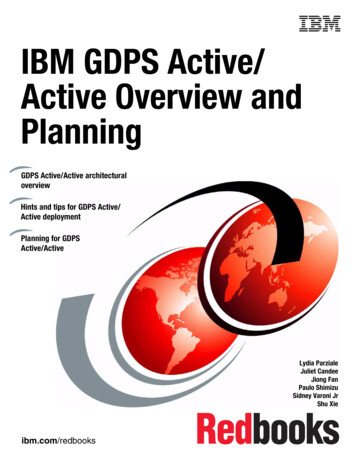
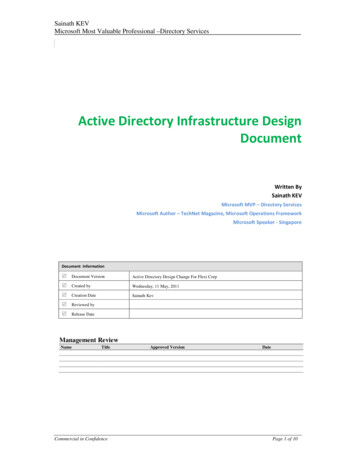
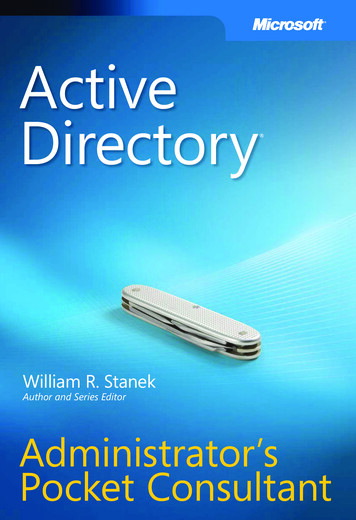

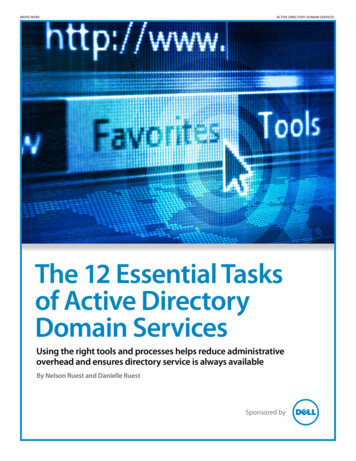
![[MS-ADFSOD]: Active Directory Federation Services (AD FS .](/img/1/5bms-adfsod-5d.jpg)
